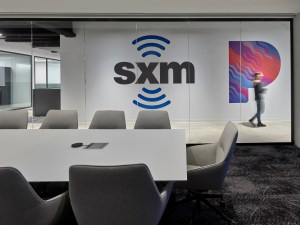Presented By: CBRE
Urban Makeovers: Complex Renovations, Real Solutions

After many years of service, the New York Public Library needed a major upgrade. The planned $200 million renovation of its main circulating branch in Midtown was long-awaited but would involve significant work to the entire structure.
This considerable undertaking, which is expected to be completed in the spring, will leave the branch with greatly expanded public space, a widened entrance, room for an expansive book collection across a five-story wall, a public roof deck and improvements to the facility’s technical and electrical systems and overall architecture.
The NYPL team trusted CBRE Project Management to oversee the job. Their expertise in all areas of commercial real estate, including managing every aspect of extensive capital projects for companies, showed NYPL that CBRE could handle the task at hand.
In the tri-state region alone, CBRE has over 350 project managers, and managed over $2 billion in capital over 200 projects in 2019.
“Our clients call us primarily for three reasons: they don’t have the internal expertise, they don’t have the time, or they don’t have the resources. Additionally, we provide market intelligence and meaningful insight related to design trends, technology and construction which is unmatched in the industry,” said Eric Wagner, managing director at CBRE Project Management, who oversees the company’s tri-state area projects. “Our role is to provide strong leadership to manage all aspects of the design and construction process and ensure projects are on time and on budget while mitigating risk. We guide the external team — architects, engineers and contractors — and also help clients who have never done this before navigate and understand the process. When challenges surface, CBRE provides solutions that allow clients to make informed decisions.”
When needed, CBRE advises on projects from the earliest stages, even helping clients choose locations.

“We assess the physical attributes of various sites to confirm if they align with the client’s needs,” said Wagner. “We advise on specific considerations that would reduce the cost, such as how much power and air conditioning is in the building, and we negotiate with landlords on clients’ behalf.”
CBRE then creates a comprehensive budget and schedule while proposing an effective strategy to execute the project. This process includes a rigorous approach to identify and mitigating risks. Afterwards, CBRE assembles the appropriate team for the project.
“If somebody told me there were 20,000 architects in New York, I would believe it,” said Wagner. “There are so many players in the market. As their trusted advisor, clients ask us who they should be talking to. We guide the clients to the right project team to ensure their success.”
CBRE recently helped expand the 48,000-square-foot offices of SiriusXM radio in Midtown Manhattan, assembling the project team, handling budgeting and scheduling and guiding the company through the design and material selection.
“The design of the SiriusXM office expansion is consistent with many new, modern Class A offices,” said Wagner. “The open-office features, bench seating, exposed ceilings, polished concrete floors, private offices and conference rooms with high-end finishes as well as new bathrooms. The scope also included an interconnecting stair to allow employees and visitor to visit all areas.”
When the project cost began to exceed the budget, CBRE responded by identifying workable alternatives that dropped the budget by up to 10 percent without sacrificing quality or design.
“They came to the table with a wish list, but after planning the design, found that it was more than they were willing to spend,” said Wagner. “We were able to save them about $19 per square foot on material selection, flooring, and lighting. When guiding clients through the design process, we are constantly monitoring if the design aligns with the budget. If it doesn’t, we work collaboratively with the project team do what’s called a “value engineering” exercise to get the project back on budget.”
Aside from the costs, CBRE was successful in proposing an effective strategy with the general contractor and subcontractors to change the sequence of the construction on a site that has a 24/7 operation with live recording studios in close proximity.
As these projects demonstrate, office space is just one area of CBRE’s project management expertise.

“Project management used to be associated with corporate office environments. Now, we’re involved in many different sectors,” said Wagner. “Libraries are one of them, education is another, plus retail, industrial, life science and health care. And our clients are not just corporate clients. We deal with institutional investors, developers and landlords from many different institutions. We have strong diversity among our clientele.”
Bret Keeney, a director at CBRE Project Management, is the project executive on the NYPL renovation.
“There were a lot of unusual challenges for us on this project, no question about it,” said Keeney. “Here at CBRE, projects of this magnitude and cost are in our wheelhouse. It’s what we do.”
The NYPL renovation involved reconstructing the entire inside of the building, cutting a hole between three floors, relocating the elevators, adding an additional floor and an overbuild of three stories that has a roof constructed of custom metal.
Keeney noted that a full renovation of an older building — the building housing the Midtown NYPL branch was built in 1914 — often comes with even greater challenges than a new construction project. In this case, CBRE discovered a unique obstacle during the demolition phase.
“Sometimes older buildings have existing conditions. This is what we in the industry mean when we say that the building is ‘talking back.’ That was the case here,” said Keeney. “A strap beam was in the ground from an earlier renovation to stabilize the building. We had engineers look at it and determined that we didn’t want to disturb that beam. The result was to redesign the location of the building’s elevators. In large renovations of older buildings this is commonplace. Our experience in dealing with the ‘known unknowns’ is another area where we bring value to our clients.”
CBRE handled all of the coordination with Tishman, the project’s construction manager, including ensuring that the project’s mechanical, electrical, plumbing (MEP) would fit into the designated space.
“We leveraged technology during the design process to ensure the construction was executed efficiently. There was an extensive amount of coordination with 3D building information modeling for the MEP,” said Keeney. “A couple of times along the way, we didn’t think it was all going to fit. We were able to work through the computer models with the NYPL, Tishman and the design teams. Once the model was finished, then it was released to the contractor to build off. In other jobs, they often just do a piece at a time. In this instance, the entire overbuild was modeled.”
CBRE also employs numerous methods for monitoring time and costs, ensuring that projects stay on schedule and on budget.
“There are a number of different ways to tell if a project is on schedule,” Keeney said. “We often look at the cash flow and see how much money a client is spending on a project per month. I can look at that and say, ‘I know you’re behind schedule because you’re not spending the money fast enough. You need to be spending $2 million or $3 million a month to keep pace with what we projected.’ That’s just one method. There are a couple of different forensic ways to constantly look and understand where the project is at any given time.”
While these projects could take months or even years, the staff generally moves on to new projects upon completion. CBRE also has a devoted project team for larger corporations, such as banks, that require project management on a dedicated, long-term basis.
“For example, we manage the entire North American portfolio for one banking client,” said Deborah Romano, Senior Director at CBRE who heads up this account team. “While we do a lot of tenant improvement work at their Manhattan headquarters, our team is also delivering projects for them around the country, wherever they have campuses. Sometimes they want to refresh the buildings they own — they may look at a building and realize that this building is 25 years old and hasn’t had any upgrades. Or they might be leasing a building and want an analysis of whether they should stay in the building and refresh it or pack up and find a new location.”
While many of these clients have dedicated real estate teams, CBRE offers a deeper well of expertise.
“We become an extension of their real estate team,” said Romano. “A banking client might have a project manager that isn’t being exposed to many of the things that our project managers, who work directly in the industry, are exposed to related to best practices, innovative tools, expertise and resources. We become an asset to our clients in terms of information sharing, risk mitigation and applying critical thinking and problem solving. We’re not just an extension of them, but more of a trusted advisor.”
CBRE Project Management becomes so deeply involved with their clients that they have started taking on risk.

“One of the key things that differentiates us is that in addition to our traditional approach of acting as a consultant, we are also able to offer clients a different type of contractual model which enables us to act in a principal role. This means that we take on risk on their behalf,” said Frank Alvarado, who oversees the Northeast region as senior managing director at CBRE Project Management. “Our principal capabilities appeal to clients for a variety of reasons. For some it’s all about the transfer of risk; for others, it’s the value we derive from compressing the supply chain. Other clients are motivated by the operational efficiencies it can create for their organizations. Whatever the motivation, clients are realizing value in new and significant ways. We don’t only give advice — we guarantee delivery and handle contracts with all of the consultants and vendors required on a project including the architects, engineers, general contractor, IT provider, among others — these people are under contract to us. If something goes wrong with the project, we own it.”
Alvarado explains that this arrangement offers benefits to both the clients and CBRE.
“Our fees are a little different when we take this kind of risk. There’s a premium,” said Alvarado. “But typically, when we do this, we save the client cost and time on the project because we eliminate some of the duplication that happens when multiple entities are working directly for the client. This is a way of compressing the supply chain and streamlining the timeline.”
CBRE can take on this sort of risk because given the company’s experience, they know they can handle any project and tackle any challenge that might occur during a renovation, no matter how complex.
“If there weren’t problems, my job would not exist, and we would not have 350 project managers on staff,” said Wagner. “Problems exist every day. We are problem solvers who work to address those issues and find solutions.”


